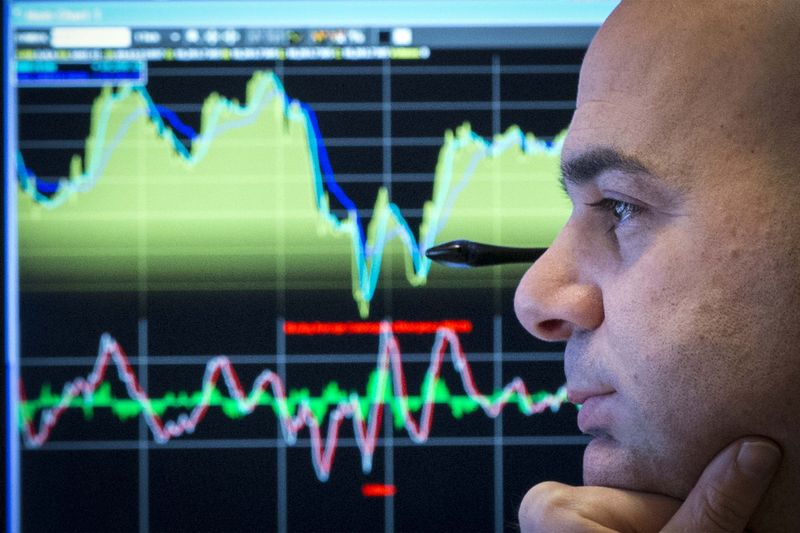BofA warns Fed risks policy mistake with early rate cuts
(Updates prices throughout, adds Japanese meeting)
* Asian stock markets : https://tmsnrt.rs/2zpUAr4
* MSCI ex-Japan skids for a seventh day in a row
* Flight to safety boosts yen, bonds and gold
* Currency wars feared as China's yuan breaks past 7 per dlr
* Japanese officials call meeting to discuss market moves
* Markets wager on even sharper U.S. monetary easing
By Swati Pandey and Wayne Cole
SYDNEY, Aug 5 (Reuters) - Asian shares suffered their
steepest daily drop in nine months on Monday, as Sino-U.S. trade
friction sent the yuan slumping to a more than decade trough and
stampeded investors into safe harbours including the yen, bonds
and gold.
Markets have been badly spooked since U.S. President Donald
Trump abruptly declared he would slap 10% tariffs on $300
billion in Chinese imports, ending a month-long trade truce.
China vowed on Friday to fight back. In response, China's yuan CNH= CNY= burst beyond the
psychological 7-per-dollar threshold in a move that threatened
to unleash a whole new front in the trade hostilities - a
currency war. "Everything is selling off right now," said Ray Attrill,
head of forex strategy at National Australia Bank in Sydney. "We
have no reason to expect any cessation in selling unless we see
any strong action to defend any CNY or CNH weakness."
"Our working assumption is that we are unlikely to see any
meaningful resolution to the trade dispute anytime soon."
Asian share markets were a sea of red with Japan's Nikkei
.N225 shedding 2.3% to the lowest since early June. It was the
sharpest daily drop since March and led Japanese officials to
call a special meeting to discuss market turmoil. Australian shares .AXJO slipped about 1.5% to spend their
fourth straight session in the red, and South Korea's KOSPI
.KS11 tumbled 2.1% to hit its lowest since December 2016.
MSCI's broadest index of Asia-Pacific shares outside Japan
.MIAPJ0000PUS sank 2.2% to depths not seen since late January.
In China, the blue-chip index .CSI300 fell 1% while the
troubled Hong Kong market .HSI hit a seven-month trough.
The pain was quick to spread, with futures for the S&P500
ESc1 , the FTSE FFIc1 and EUROSTOXX STXEc1 all down more
than 1%.
Oil prices were dragged down on demand worries, while gold
climbed 0.8% to $1,452.17 an ounce XAU= .
The grim mood followed declines on Wall Street on Friday
with MSCI's gauge of world stocks .MIWD00000PUS posting its
largest weekly loss of the year.
The trade dispute between the world's two largest economies
has already disrupted global supply chains and investment.
The abrupt escalation capped a critical week for global
markets after the U.S. Federal Reserve delivered a widely
anticipated interest rate cut and played down expectations of
further easing.
EVER DEEPER CUTS
So far, investors are not buying Fed Chairman Jerome
Powell's claim that the 25-basis-point rate reduction was a mere
"mid-cycle adjustment to policy".
Futures are now pricing in deeper cuts than before last
week's Fed meeting. The terminal U.S. rate 0#FF: is seen at
1.22%, 93 basis points below the current effective rate.
Analysts at TD Securities are forecasting no less than five
more cuts from the Fed, amounting to 125 basis points of easing,
over the coming year or so.
Bond markets were well ahead of the game as U.S. 10-year
yields US10YT=RR dived 7 basis points to 1.77%, a violent
shift for usually cautious Asian hours. Yields in Australia and
New Zealand touched all-time lows.
German 10-year government bond yields DE10YT=RR dropped on
Friday to an all-time low of -0.502% and the country's entire
government bond yield curve turned negative for the first time
ever. The flight to safety lifted the yen, which often gains at
times of stress thanks to Japan's position as the world's
largest creditor. The dollar slipped to a seven-month trough of
105.78 yen JPY= , while the euro sank to its lowest since April
2017 at 117.64 yen EURJPY= .
That dragged the dollar index .DXY off 0.1%, though it was
up against most other Asian currencies and those exposed to
China or commodities including the Australian dollar.
The Aussie AUD=D3 , a liquid proxy for emerging market and
China risk, slipped to a fresh seven-month trough at $0.6748
after losing 1.6% last week.
The Swiss franc CHF= was boosted by safe-haven demand from
the escalating trade tensions. Trump is also eyeing tariffs on
the European Union, but is yet to make any formal announcements.
The euro EUR= was relatively steady on the dollar at $1.1125.
Sterling GBP= hovered near 2017 lows at $1.2150, pressured
by concerns about Britain exiting the European Union without a
deal in place. Oil extended losses with U.S crude CLc1 off 26 cents at
55.40 and Brent LCoc1 down 35 cents at $61.54.
<^^^^^^^^^^^^^^^^^^^^^^^^^^^^^^^^^^^^^^^^^^^^^^^^^^^^^^^^^^^
Asia stock markets https://tmsnrt.rs/2zpUAr4
Asia-Pacific valuations https://tmsnrt.rs/2Dr2BQA
^^^^^^^^^^^^^^^^^^^^^^^^^^^^^^^^^^^^^^^^^^^^^^^^^^^^^^^^^^^>
(Editing by Richard Borsuk and Jacqueline Wong)
